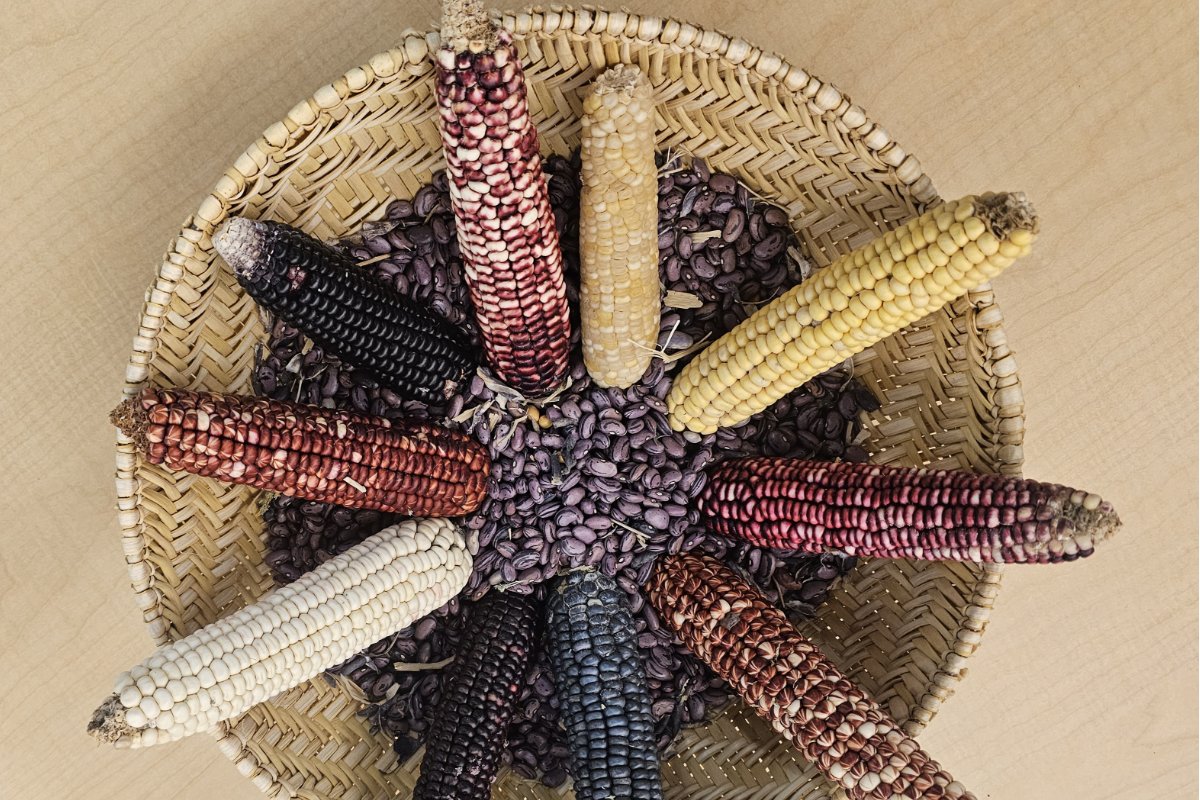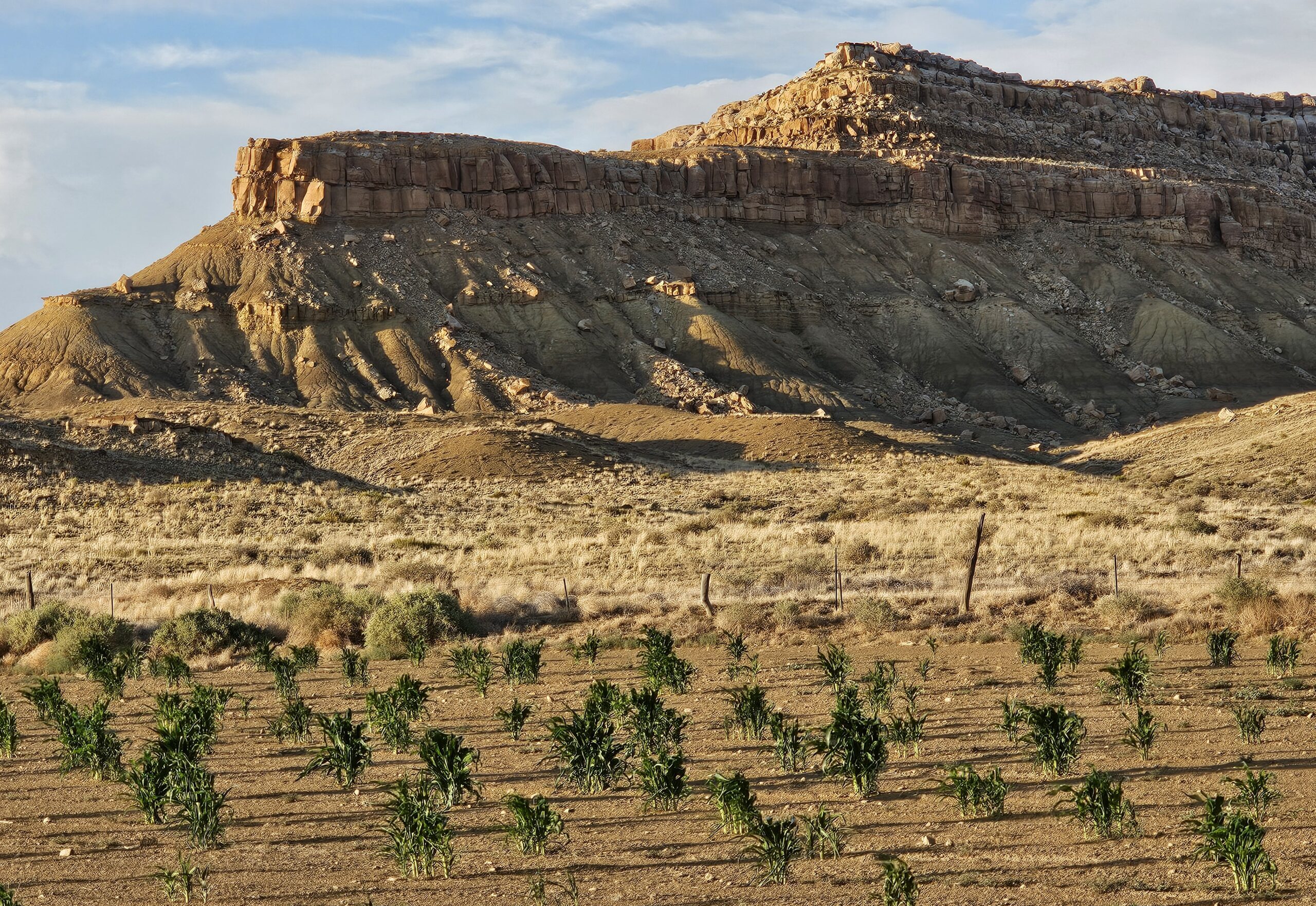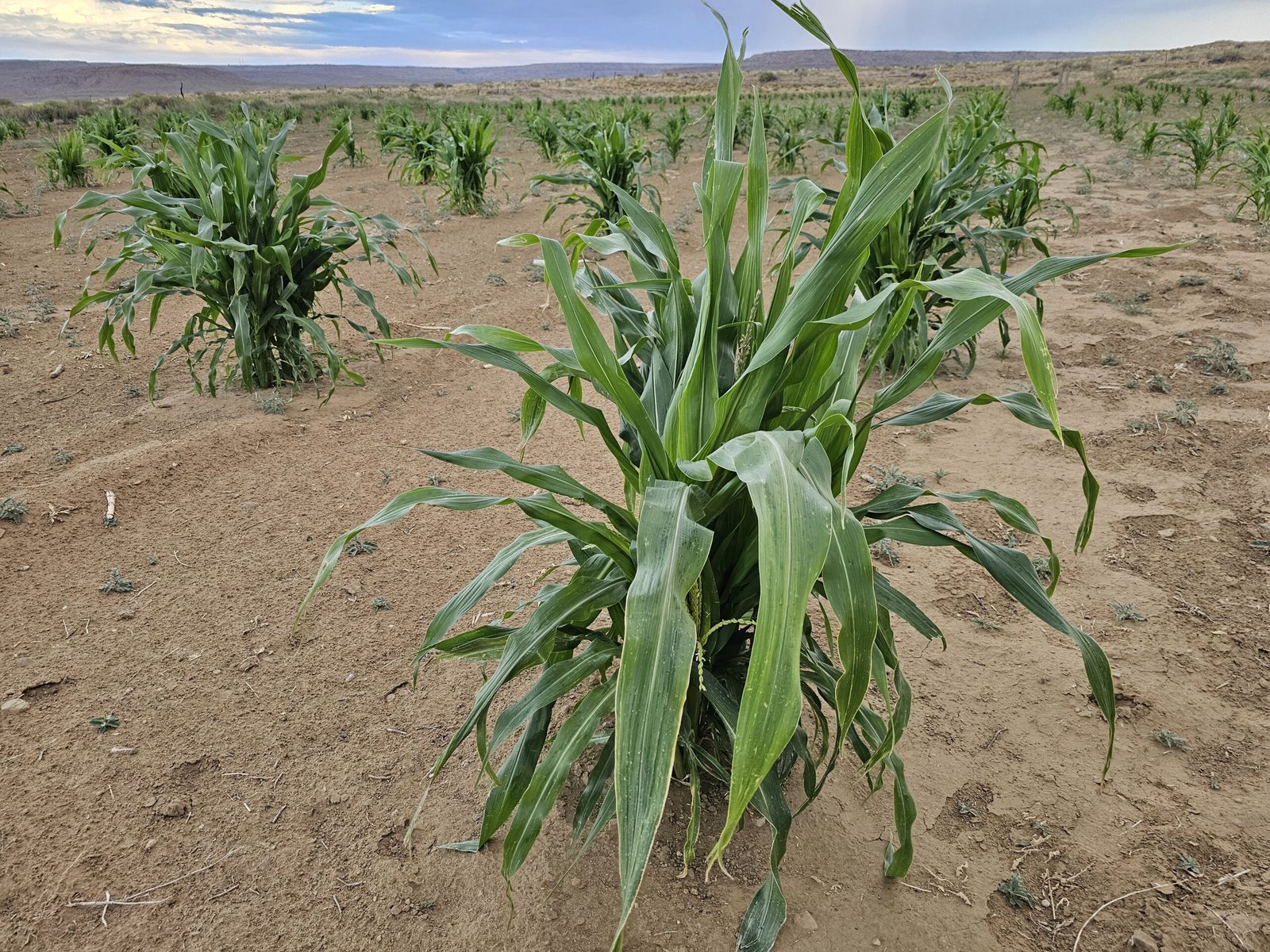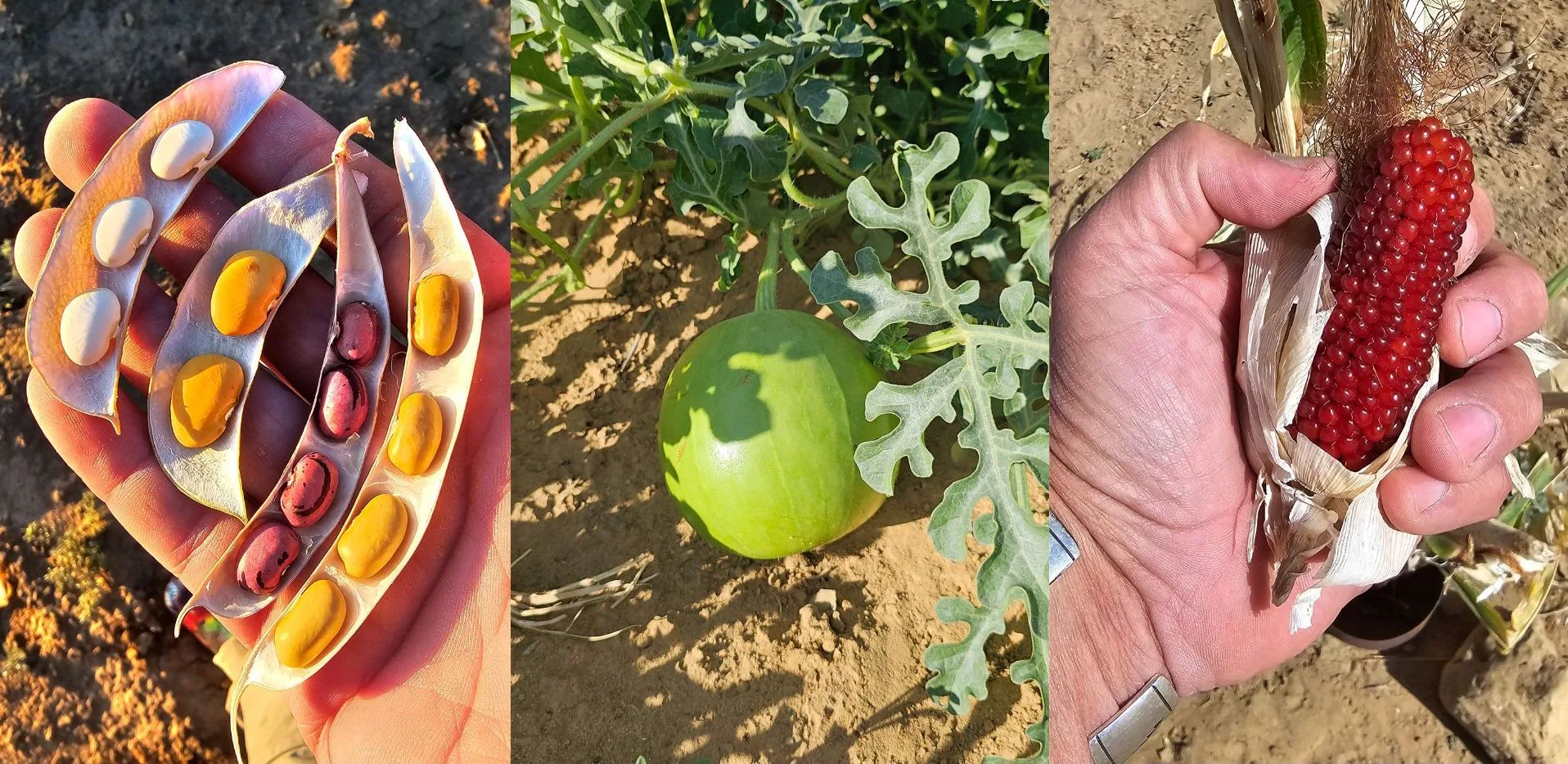The surreal sight of squash, melons, and corn sprouting from the sandy ground reflects an ancient Hopi farming technique that’s newly relevant.

The surreal sight of squash, melons, and corn sprouting from the sandy ground reflects an ancient Hopi farming technique that’s newly relevant.
January 7, 2025

Hopi corn varieties. (Photo courtesy of Michael Kotutwa Johnson)
This story originally appeared on Reasons to Be Cheerful, and is reprinted here with permission.
Expand your understanding of food systems as a Civil Eats member. Enjoy unlimited access to our groundbreaking reporting, engage with experts, and connect with a community of changemakers.
Already a member?
Login
When Michael Kotutwa Johnson goes out to the acreage behind his stone house to harvest his corn, his fields look vastly different from the endless rows you see in much of rural North America. Bundled in groups of five or six, his corn stalks shoot out of the sandy desert in bunches, resembling bushels rather than tightly spaced rows. “We don’t do your typical 14-inch spaced rows,” he says.
Instead, Kotutwa Johnson, an enrolled member of the Hopi tribe, practices the Hopi tradition he learned from his grandfather on the Little Colorado River Plateau near Kykotsmovi Village in northeastern Arizona, a 90-minute drive from Flagstaff: “In spring, we plant eight to 10 corn kernels and beans per hole, further apart, so the clusters all stand together against the elements and preserve the soil moisture.” For instance, high winds often blow sand across the barren plateau. “This year was a pretty hot and dry year, but still, some of the crops I raised did pretty well,” he says with a satisfied smile. “It’s a good year for squash, melons, and beans. I’ll be able to propagate these.”

Hopi corn fields look vastly different from the tight rows typically seen across North America. Little Colorado River Plateau, northeast Arizona. (Photo courtesy of Michael Kotutwa Johnson)
Dry farming has been a Hopi tradition for several millennia. Kotutwa Johnson might build some protection for his crops with desert brush or cans to shield them from the wind, but his plants thrive without any fertilizer, pesticides, herbicides, mulch, or irrigation. This is all the more impressive since his area usually gets less than 10 inches of rain per year.
“We chose this land, and we’ve learned to adapt to our harsh environment. The culture is tied into our agricultural system, and that’s what makes it so resilient.”
In the era of climate change, the practice of dry farming is met with growing interest from scientists and researchers as farmers grapple with droughts and unpredictable weather patterns. For instance, the Dry Farming Institute in Oregon lists a dozen farms it partners with, growing anything from tomatoes to zucchini. However, Oregon has wet winters, with an annual rainfall of over 30 inches, whereas on the plateau in Arizona, Johnson’s crops get less than a third of that. Farmers in Mexico, the Middle East, Argentina, Southern Russia, and Ukraine all have experimented with dry farming, relying on natural rainfall, though conditions and practices vary in each region.
For Kotutwa Johnson, it’s a matter of faith and experience. Between April and June, he checks the soil moisture to determine which crops to plant and how deep. He uses the traditional wooden Hopi planting stick like his ancestors, because preserving the topsoil by not tilling is part of the practice. “We don’t need moisture meters or anything like that,” he explains. “We plant everything deep—for instance, the corn goes 18 inches deep, depending on where the seeds will find moisture.” His seeds rely on the humidity from the melted winter snow and annual monsoon rains in June.
His harvest looks unique, too. “We know 24 varieties of indigenous corn,” he says, showing off kernels in indigo blue, purple red, snow white, and yellow. His various kinds of lima and pinto beans shimmer in white, brown, merlot red, and mustard yellow. Studies have shown that indigenous maize is more nutritious, richer in protein and minerals than conventional corn, and he hopes to confirm similar results with his own crops in his role as professor at the School of Natural Resources and the Environment at the University of Arizona, and as a core faculty member with the fledgling Indigenous Resilience Center, which focuses on researching resilient solutions for Indigenous water, food, and energy independence. He earned a PhD in natural resources, concentrating on Indigenous agricultural resilience, not least to “have a seat at the table and level the playing field, so mainstream stakeholders can really hear me,” he says. “I’m not here to be the token Native; I’m here to help.” For instance, he attended COP 28, the 2023 United Nations climate change conference in Dubai, to share his knowledge about “the reciprocal relationship with our environment.”
Kotutwa Johnson was born in Germany because his dad was in the military, but he spent the summers with his grandfather planting corn, squash, beans, and melons the Indigenous way in the same fields he’s farming now, where he eventually built an off-grid stone house with his own hands. “As a kid, I hated farming because it’s hard work,” he admits with disarming honesty, followed by a quick laugh. “But later I saw the wisdom in it. We’ve done this for well over 2,000 or 3,000 years. I’m a 250th-generation Hopi farmer.”
Unlike many other Indigenous tribes, the Hopi weren’t driven off their land by European settlers. “We’re very fortunate that we were never relocated,” Kotutwa Johnson says. “We chose this land, and we’ve learned to adapt to our harsh environment. The culture is tied into our agricultural system, and that’s what makes it so resilient.”
However, the Hopi tribe doesn’t own the land. Legally, the United States holds the title to the 1.5 million acres of reservation the Hopi occupy in Northwestern Arizona, a fraction of their original territory. Kotutwa Johnson estimates that only 15 percent of his community still farms, down from 85 percent in the 1930s, and some Hopi quote the lack of land ownership as an obstacle.

Hopi corn thrives without fertilizers, herbicides, mulch, or irrigation. (Photo courtesy of Michael Kotutwa Johnson)
Like on many reservations, the Hopi live in a food desert, where tribal members have to drive one or two hours to find a major supermarket in Flagstaff or Winslow. High rates of diabetes and obesity are a consequence of lacking easy access to fresh produce. “If you’re born here you have a 50 percent chance of getting diabetes,” Kotutwa Johnson says. “To me, this is the original harm: the disruption of our traditional foods. By bringing back the food, you also bring back the culture.”
Traditionally, Hopi women are the seed keepers, and the art of dry farming starts with the right seeds. “These seeds adapted to having no irrigation, and so they are very valuable,” Kotutwa Johnson says. He is fiercely protective of the seeds he propagates and only exchanges them with other tribal members within the community.

Left to right: A variety of Hopi beans, a squash in the field, and an old Hopi corn variety grown from an 800-year-old seed. (Photo courtesy of Michael Kotutwa Johnson)
In that spirit, he was overjoyed to receive 800-year-old corn ears from a man who recently found them in a cave in Glen Canyon. Kotutwa Johnson planted the corn, and about a fifth actually sprouted. He raves about the little white corn ears he was able to harvest: “It’s so amazing we got to bring these seeds home. It was like opening up an early Christmas present.”
From a traditional perspective, “we were given things to survive,” he says. “In our faith, we believe the first three worlds were destroyed, and when we came up to this world, we were given a planting stick, some seeds, and water by a caretaker who was here before us.”
He doesn’t believe that climate change can be stopped. “But we can adapt to it, and our seeds can adapt.” This is a crucial tenet of Hopi farming: Instead of manipulating the environment, they raise crops and cultivate seeds that adjust to their surroundings. His crops grow deep roots that stretch much farther down into the ground than conventional plants.
“Our faith tells us that we need to plan every single year no matter what we see,” even in drought years, he explains. “Some years, we might not plant much, but we still plant regardless because those plants are like us, they need to adapt.”
Dry farming is “not very economically efficient,” he admits. “Everything is driven towards convenience nowadays. We’re not trying to make a big buck out here; we’re here to maintain our culture and practice things we’ve always done to be able to survive.”
Kotutwa Johnson does not sell his produce. He keeps a percentage of the seeds to propagate and gives the rest to relatives and his community, or trades it for other produce.
But his vision far surpasses his nine acres. He wants to pass on his dry-farming methods to the next generation, just as he learned them from his grandfather, and he often invites youth to participate in farming workshops and communal planting. That’s why he recently started the Fred Aptvi Foundation, named after his grandfather, to focus on establishing a seed bank and a Hopi youth agricultural program that incorporates the Hopi language. Aptvi means “one who plants besides another,” Kotutwa Johnson explains. “It’s about revitalizing what’s there, not reinventing it.”

July 30, 2025
From Oklahoma to D.C., a food activist works to ensure that communities can protect their food systems and their future.
Like the story?
Join the conversation.